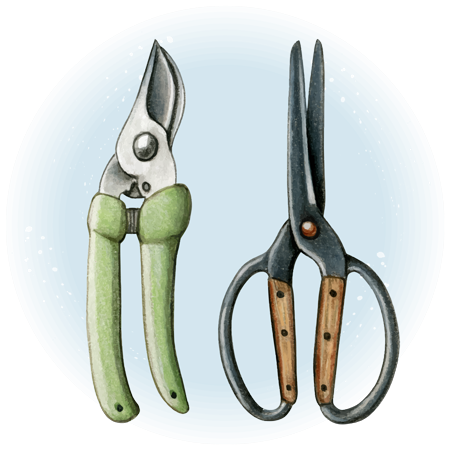Salvia Small Talk: Deadheading Evergreen, Woody Salvias

Removing withered Salvia blossoms that are beginning to go to seed is called deadheading — a light form of pruning. This is trimming done in late spring and summer to make plants look tidier and encourage repeat blooming during the growing season. How to deadhead a Salvia depends on its form of growth, which may be one of four types: Rosette-growing herbaceous perennial; soft-stemmed deciduous or semi-evergreen sage; deciduous, woody-stemmed sage; or evergreen shrub. Many Salvias in each of these categories can thrive as annuals in areas where winters are too cold for perennial growth. Deadheading increases bloom for your buck, especially for sages grown as annuals.
Evergreen, woody Salvias range from cold-hardy types like Giant Purple Desert Sage (Salvia pachyphylla ‘Blue Flame’) to ones, such as Sacred White Sage (Salvia apiana) that need warmer winter temperatures and withstand intense summer heat.
Here are a few more examples of evergreen, woody Salvias grown at Flowers by the Sea Farm for sale through our online nursery:
- Rusty Sage (Salvia lanceolata) from South Africa’s Cape of Good Hope
- Corrugated Sage (Salvia corrugata) from the Ecuadorian Andes
- Mr. Jules Hybrid Sage (Salvia x ‘Mr. Jules’) from a cross of Mexican sages at the University of California, Santa Cruz, and
- Rhythm and Blues Anise-Scented Sage (Salvia BODACIOUS® ‘Rhythm and Blues’) an FBTS hybrid related to South American Salvia guaranitica.
The term “evergreen” doesn’t mean that a shrub Salvia never loses leaves. New growth emerges as old leaves drop, creating the impression that the foliage is permanent. As with any sage, deadheading spent flowers gives these plants a tidier look and promotes continuing bloom. Throughout the growing season, you can encourage fresh growth by periodically removing the oldest stems. But remember the birds: Many gardeners who grow woody, evergreen sages are intent on feeding small wildlife, including the songbirds that love Salvia seed. In that case, leave flowers alone until you are ready to shape and tidy the entire plant — pruning that can occur in any season.
The size of bypass hand pruners — secateurs — to use depends on your task. Snips work well for flowers but medium-size secateurs are better for old wood.
Questions and More Information
The plant description pages in our online catalog contain a wealth of information about plant characteristics and needs. Page features include a button saying, “How to Prune this Plant.” It leads to a pop-up box identifying the plant’s form of growth and basic information about pruning.
If you have more questions about pruning or any of the plants we grow, please contact us. We’re glad to listen and share what we know.

 Salvia corrugata
Salvia corrugata  Salvia lanceolata
Salvia lanceolata  Salvia BODACIOUS 'Rhythm and Blues'
Salvia BODACIOUS 'Rhythm and Blues'  Salvia x 'Mr. Jules'
Salvia x 'Mr. Jules'  Salvia apiana
Salvia apiana  Salvia pachyphylla 'Blue Flame'
Salvia pachyphylla 'Blue Flame'
Comments
There are no comments yet.